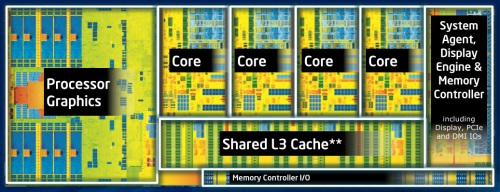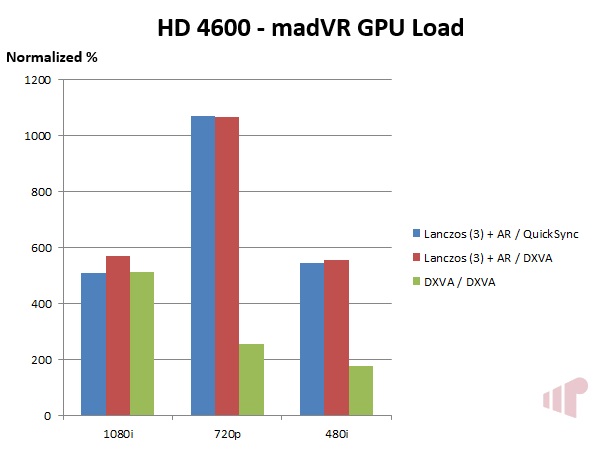Intel HD 4600 – madVR Performance

As many in the home theater PC (HTPC) community are aware, madVR produces an unparallelled level of flexibly and performance. Producing results that rival some of the best dedicated video processors available in the market. It was not that long ago that utilizing this advanced video renderer was limited to those with a high-end discrete graphics processing unit (GPU) and a penchant for mixing PC usability with HTPC use cases. Time and Moore’s Observation (er… “Law”) has changed this with the feature available through 10′ friendly user interfaces (UI).
The previous generation HD 4000 GPU found in Intel integrated processor graphics (IPG), “Ivy Bridge”, was the first Intel graphics solution to combine decent coverage for this feature and modern CPU performance. It was hoped that the 4th generation “Haswell” IPG would finally unlock the full capability of madVR, but as was mentioned in our first look at the Intel Core i7-4770K the HD 4600 could not. Having spent more time with the platform, it was time to revisit this issue and provide a more detailed look at what is, and is not, possible.
Lanczos 3 tap + Anti-ringing
Like the Intel HD 4000, Haswell’s Intel HD 4600 is capable of processing video using the demanding Lanczos (3 tap) algorithm, but with the additional ability to activate the Anti-ringing filter. In the video above, three videos (1080i30, 720p60, and 480i30) are displayed during playback with madVR. As we can see it is able to scale and process the videos without issue.
Jinc 3 tap + Anti-ringing
The same cannot be said after enabling the more demanding Jinc algorithm. In the clip above we can see that the video is unwatchable with this algorithm enabled. Not even 1080i30 will play without serious performance issues.
DXVA
Intel’s hardware scaling is very good, so it was heartily welcomed when madVR added the ability to enable DXVA scaling (which is how the hardware is exposed). As we can see here, not only can the Intel HD 4600 handle the three clips examined before, it can also downscale and process 4K content.
GPU Load
It was pointed out in the comments that GPU utilization should have been included, and I agree. So I went back and reran the tests to produce the chart above. The numbers are not presented as a percent because the HD 4600’s GPU dynamically clocks based on load, so the values have been normailzed to the maximum frequency (1250MHz) so a more accurate comparison can be presented. Only the methods that produced acceptable results were included in the “scaling method / decoding method” format.
Wrapping Up
While it is unfortunate that the Intel HD 4600 GPU clearly does not have the necessary “go” to unlock madVR’s full potential, there is there are three steps above it in Haswell’s graphics lineup so there is some chance that the 4th generation Intel Core IPG can handle Jinc. Currently those SKUs are limited to mobile however, so it possible that we will never see suitable HTPC systems with Intel Iris 5100/5200 GPUs. The upcoming Haswell NUC should ship with Intel HD 5000 though, so we can look forward to running it through the same series of tests when it arrives later this year.
Thanks to Intel for providing the review sample.

FYI – the first video was
FYI – the first video was removed thanks to DMCA take down
Also, I would have like to have seen how much of the GPU was in use. Running GPU-Z simultaniously would have been nice.
Thanks. I’ll take a look.
Thanks. I’ll take a look.
sogetthis wrote:
Also, I
[quote=sogetthis]
Also, I would have like to have seen how much of the GPU was in use. Running GPU-Z simultaniously would have been nice.
[/quote]
I forgot that GPU-Z can log data. Will try to collect that later.
babgvant wrote:
sogetthis
[quote=babgvant]
[quote=sogetthis]
Also, I would have like to have seen how much of the GPU was in use. Running GPU-Z simultaniously would have been nice.
[/quote]
I forgot that GPU-Z can log data. Will try to collect that later.
[/quote]
Added. Thanks for the feedback.
Andy,
If I wanted to use a
Andy,
If I wanted to use a discreet GPU for MadVR , in your opinion, what would be the min requirements to get excellent results?
Thanks!
VINYLFREAK4 wrote:
Andy,
If
[quote=VINYLFREAK4]
Andy,
If I wanted to use a discreet GPU for MadVR , in your opinion, what would be the min requirements to get excellent results?
Thanks!
[/quote]
It depends on whether you want to use Jinc and what the maximum resolution (i.e. is 4K a requirement?) are. If it’s everything, you’ll need a monster.
We haven’t been the best at keeping up with the mid-level dGPU models and their suitability for HTPC lately. Personally, I’ve lost most of my interest here because the IPGs from Intel & AMD have done such a good job of strangling advancements in that space so most of the mid-level cards we have now are just minor tweaks on the cards we had 2 years ago with a bump in marketing nomenclature (when a GT-440 with fast RAM was a safe bet).
That said, because madVR is essentially a DirectX game, it’s relatively straightforward to determine relative performance using gaming benchmarks as a proxy.
VINYLFREAK4 wrote:
Andy,
If
[quote=VINYLFREAK4]
Andy,
If I wanted to use a discreet GPU for MadVR , in your opinion, what would be the min requirements to get excellent results?
Thanks!
[/quote]
I had an Intel e2180 (OC’d @ 2.66Ghz and 1066 FSB) with a 500MB AMD HD 4670. It struggled with Bicubic/Lanczos with AR enabled on 50 FPS+ but was fine without AR. It couldn’t handle “DXVA native” in LAV filters but works fine with software decoding.
I currently have a Corei3 530 (OC’d @ 3.78Ghz and 1700 Mhz memory) with an AMD HD 6570. It handles Bicubic/Lanczos with AR and “DXVA native” without issue and utilizes up to ~75% of the GPU at peak (never drops frames). With software decoding it uses ~65% at max. This is what I would consider the “minimum” for an AMD card. An HD 6670 (or A8 APU) would be what I’d recommend though (future proof).
Jinc is VERY power hungry and results in a minimal quality gain (imo) and requires a much faster card.
Thank you Andrew for the
Thank you Andrew for the update with GPU useage!
Thanks! for all the feedback
Thanks! for all the feedback to my question , guys. Very good info.
I just picked up a core i5
I just picked up a core i5 with the 4600 graphics.
At the end of this review I was hoping to see suggested settings
Would you suggest Lancos 3 taps + AR for all three (Chroma, Luma up/down)?
Well that’s the thing about
Well that’s the thing about madVR, it’s all about your preference :).
I use Lanczos 3 tap w/ AR for upscaling & DXVA2 for downscaling.
Hi Andy,
I had a haswell
Hi Andy,
I had a haswell i5-4670k with HD4600 too.
And I can use madVR 0.86.10(chrome: Jinc3+AR, up&down scaling:DXVA2, and smooth motion FRC function ON) to render UHD movies without any drop frames.
HD4600 can handle it, just need some tunings in madVR.
You can try it with these settings in madVR as following:
“trade quality for performance”
uncheck all options.
FYI.
*one more important point: rember assign memory “as much as possible” for iGPU in BIOS.
LiNcUtT wrote:
And I can use
[quote=LiNcUtT]
And I can use madVR 0.86.10(chrome: Jinc3+AR, up&down scaling:DXVA2, and smooth motion FRC function ON) to render UHD movies without any drop frames.
[/quote]
Using DXVA2 for up/down scaling this is possible (this was . The HD4600 falls down when you try to use Jinc3 for this task.
That’s not to say that DXVA2 isn’t a good choice, just that the HD4600 cannot replace a dGPU if you want more flexibility when selecting the scaling algorithm.